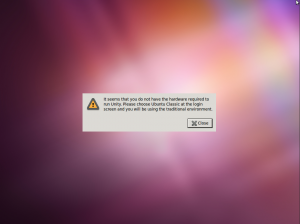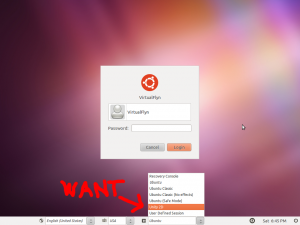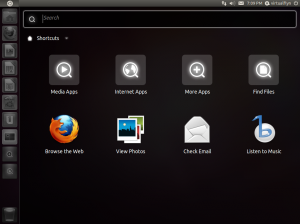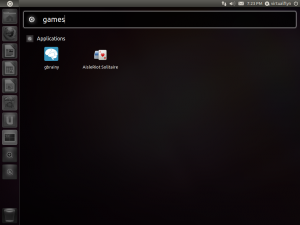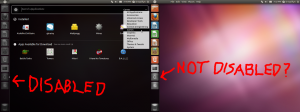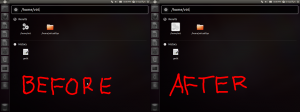Note: Also see the followup to this post: How to Make Ubuntu 11.10 More Usable
So my previous post How to Move App Menus Back Into Their Windows in Ubuntu turned out a little more bitter than even I had first intended. As a result I think it’s only fair I give a few more reasons as to why I have such a strong dislike towards Unity.
Let me preface this post by saying that I was actually quite looking forward to Unity. It looked relatively promising (although I was slightly worried about reports it wasn’t as customizable as Gnome) and after I ended up liking icons on the left when thinking I wouldn’t, I was determined to give Unity a fair go. I would also like to say that many of these issues will probably be sorted out in later bug fixes and updates – but that does not help me right here right now on my shiny new Ubuntu install a few days after release.
So here it is: a ‘by no means complete’ list of reasons using Unity is not a good idea at this point in time.
First impressions
Upon installing Ubuntu and booting it up for the first time, chances are you’ll be greeted with the screen below:
This screen is bad for several reasons:
- It’s not themed the way you’d expect (ie the same way every other alert box looks in Ubuntu). In fact it started out looking like a standard alert box then changed to the one you see in the image.
- It wastes my time. If I can’t load Unity right now, why not have the error say something along the lines of ‘The traditional environment will be loaded for you instead.’ rather than sending me back to the login screen to do it myself? What’s the first thing your grandma is going to do when she sees this message? You think she’s going to do what the message says? No. She’s going to call you and ask you why it’s not working. In addition, despite what the message says – it DOES load Ubuntu Classic for you. I think this one can just be chalked up to a developer not updating the message later on in the development cycle.
- It’s not even right. I DO have the hardware required to run unity – it’s just not configured correctly yet. When installing Ubuntu 11.04 for the first time, I was installing it on a laptop with an NVidia 8600M GT discrete GPU, 1.8GHz dual core CPU, 3GB DDR2 RAM and 500GB HDD. That should easily fulfill any requirements unity may have. The reason the message appeared is because out of the box, Ubuntu put me on Noveau 2D open source drivers instead of NVidia Proprietry or Noveau 3D experimental. Why not provide the option to enable these and continue? I ended up needing to load Ubuntu Classic, navigate to System – Administration – Additional Drivers, select NVidia current and reboot.
3D Or It Didn’t Happen
With the above in mind, why is Unity 2D not shipped with Ubuntu? With a large percentage of the marketplace not having the required drivers configured during install (not to mention anyone VMing Ubuntu), wouldn’t it make sense to include this? Unity was one of the largest and most hyped new additions to 11.04 – why would you purposely inconvenience or worst case scenario lock out entirely those users? I understand arguments about disc space but if you’re putting so much dev and marketing time into Unity at least have it available to your users!
Update: Looks like this is now in the blueprint for 11.10!
WARE R MAH APPZ???
In a traditional desktop you generally have a single button (think Windows Start button or Ubuntu Classic Ubuntu button) which opens up a list of your installed applications. Just about every application is there and they’re all visible in one single place. Unity has decided to throw this concept out the window.
When looking for your applications in Unity – most people will do exactly what they’ve always done; they’ll click the Ubuntu logo in the top left. However instead of the concise, useful list they’re expecting, they’ll be presented with the following:
WTF is this? Where are my installed applications? Yes I can search for apps if I already know what their names are…but what if I’ve forgotten the name?
Let’s take games for example. Ubuntu 11.04 comes with the following games installed:
AisleRiot Solitaire, gbrainy, Mahjongg, Mines, Sudoku
Do you seriously expect the average Joe to remember the names of every app installed on his system or enough to type into the search bar (especially when alot of linux apps have traditionally cryptic names)??? If you answered yes to this question: Fuck you.
Wouldn’t it be so much easier if there was some sort of menu that listed all your games…you know…like there used to be? Even if I type ‘games’ into the search field – this is what I’m presented with:
Now let’s incorrectly assume that most people will figure out before punching their monitor that the magnifying glass icon in the left panel with the + symbol inside it that looks as if it’s disabled is the new location of your applications list. Is this well hidden window not an exact duplicate of what the old application menu used to be, only it takes up a full screen instead of just the top left while providing almost no additional, useful information?
Walk Before You Run
So far none of this has affected me too badly. I know the names of my apps and I rarely used the Applications menu anyway – preferring the run window (Alt+F2) instead. Run is also an extremely handy tool for navigating to folders quickly. SURELY they couldn’t have screwed that up right guys….? Guys?????
Unfortunately the guys decided to run away instead of answering and it quickly became apparent why.
In the past, say I wanted to navigate to /home/virtualflyn/Pictures/Wallpapers/ubuntu. This is what I’d type into the run menu:
/home/virt<tab>/Pic<tab>/Wal<tab>/u<at which point the rest of the word would be highlighted and I could just press enter> |
No such convenience with Unity. Instead of intuitively assuming you’re looking for a folder and autocompleting, it instead highlights the first result it’s found – which is stupidly exactly what you’ve just typed. The below is an image before and after hitting tab after typing /home/virt:
Panels? What Panels?
A little off the top, please
Unity has gone out of its way to make panels less useful. Almost all customization options are a thing of the past.
- You may no longer right click on the top panel and add widgets such as CPU meter
- You may no longer reorder your window list (now in a massively thick panel on left instead of at the bottom)
- You may no longer add panels or remove panels you don’t want
- You may no longer remove the Trash icon from your panel
- You may not move your panels to your preferred side of the screen
Essentially what you get when you first install Ubuntu is what you’re stuck with.
In addition, system tray icons are now gone – replaced with ‘indicator applets’. This means all applications not supporting indicator applets (95% of apps out there) will just have their system tray icons not show. The results of this are twofold:
- All applications are now slowly adding their own indicator applets – essentially recreating the system tray but with alot of wasted development time, less useful behavior (left clicking will no longer open your contact list in your favourite IM client – it’ll just bring up the old right click menu) and alot of apps are missing entirely.
- Mass confusion as apps’ icons are no longer immediately visible to the user. Music apps are hidden away in the sound applet. Most apps won’t be there at all. Some (such as Pidgin) are now under the ‘envelope’ icon – which is stupidly confusing and making it a huge chore just to figure out how to open your contacts list.
The purpose of indicator applets was to move all applications into applet categories. In theory this makes sense, however in practice (at least so far) it’s been a massive failure.
A little on the side, please
The left panel is actually one of the best parts about Unity. That’s not to say it’s great – or even good for that matter – it’s just not as bad as the rest. During the beta stages it was thought this panel would autohide and only be visible if you moved your mouse to the side of the screen. This is still the case if you maximize your window but if not you’re out of luck – it’ll stay there in all its chunky, real estate hogging glory. If you’re on a netbook you might appreciate this behavior but for 24″ monitors (ie the other 99% of the market) you probably won’t have your applications maximized and therefore won’t appreciate it.
You gotta work for that menu, bitch!
Here’s a niggling usability issue mac users will be familiar with. Menus are no longer attached to the top of the application windows they belong to. Instead all menu bars are hidden from every window except the active window – which is now displayed in the panel at the top of the screen next to the Ubuntu button. For users on 24″ monitors, this means a long trek with your mouse to the outer reaches of your screen to do something as simple as cut and paste (sorry, anyone who doesn’t use keyboard shortcuts for absolutely everything – you get nothing but a big slap in the face). To all you mac users reading this post, Unity has one-upped you in usability retardation. Not only is the applications menu bar now on the top panel of the screen, but it’s also hidden until you mouse over it! When not mouseover’d you now only see the applications title.
For more information and instructions moving menus back onto their application windows see this post.
Don’t Scroll Me, Bro
Not even scrollbars made it out of the Unity disaster unscathed. In Unity scrollbars are now thin lines with a small section highlighted to indicate where the grabber is. This means you can no longer quick-jump to specific locations by clicking on the scrollbar outside the grabber. In fact, there aren’t even any up or down arrows anymore – you’re relying completely on a mouse wheel and if you don’t have one (or yours is broken) then you’d better hope the up/down keys on your keyboard to the job.
Adding to this is the fact that the implementation isn’t as good as it should be. You can mouseover the grabber area and your grabber will appear. You can move your mouse up and down and the grabber will move with your mouse. If, however, you move your mouse over an empty section of the scrollbar without first going through the grabber area, you don’t get the grabber appear where your mouse is (ie you can’t just to a specific spot on the scrollbar). See the image below for details:
While this is only a small issue, it’s still an issue. It removes useful functionality for the sake of clearing up a few pixels worth of space. This is not an improvement at all.
Update: You can revert to the old style scrollbars with the following (You’ll need to restart afterwards):
Update 2: There’s now an OMG! Ubuntu article about removing them: http://www.omgubuntu.co.uk/2011/05/disable-the-resize-grip-in-ubuntu-11-04/
sudo apt-get remove overlay-scrollbar sudo su echo "export LIBOVERLAY_SCROLLBAR=0" > /etc/X11/Xsession.d/80overlayscrollbars |
Death By A Thousand Cuts
There are many other niggling issues with Unity as it stands today, most notably
- The UI is quite sluggish even on hardware that should allow it to fly along smoothly.
- After tabbing out of the search box in the run menu (Alt+F2), you can no longer type or even click on the search box to return focus to it – your options are to close and reopen the run menu or shift+tab your way back to the search box.
Hopefully both of these will be fixed soon – I would have liked a little more care put into issues such as these though before release.
Heavy Lubrication Advised
…and there you have it. These are some of my most major gripes with Unity (the ones discovered after only a few minutes of use). As it stands at the moment, Unity is nothing more than a tool to get people off their PCs and outside doing other things. A UI overhaul such as Unity should have been given far more thought and far more testing before release than it was and keeping to the 6 month release cycle has definately hurt Ubuntu’s reputation for usability in this case.
The IRC channels are flooded with queries and complaints and users have been leaving for alternative distributions in droves. It would seem Unity is nothing more than a Mark Shuttleworths pet project and not something Ubuntu’s users actually want.
PS. Thanks to Andrew for his excellent tutorial here which helped me get Unity working in Virtualbox making this post possible.
Note: Also see the followup to this post: How to Make Ubuntu 11.10 More Usable
